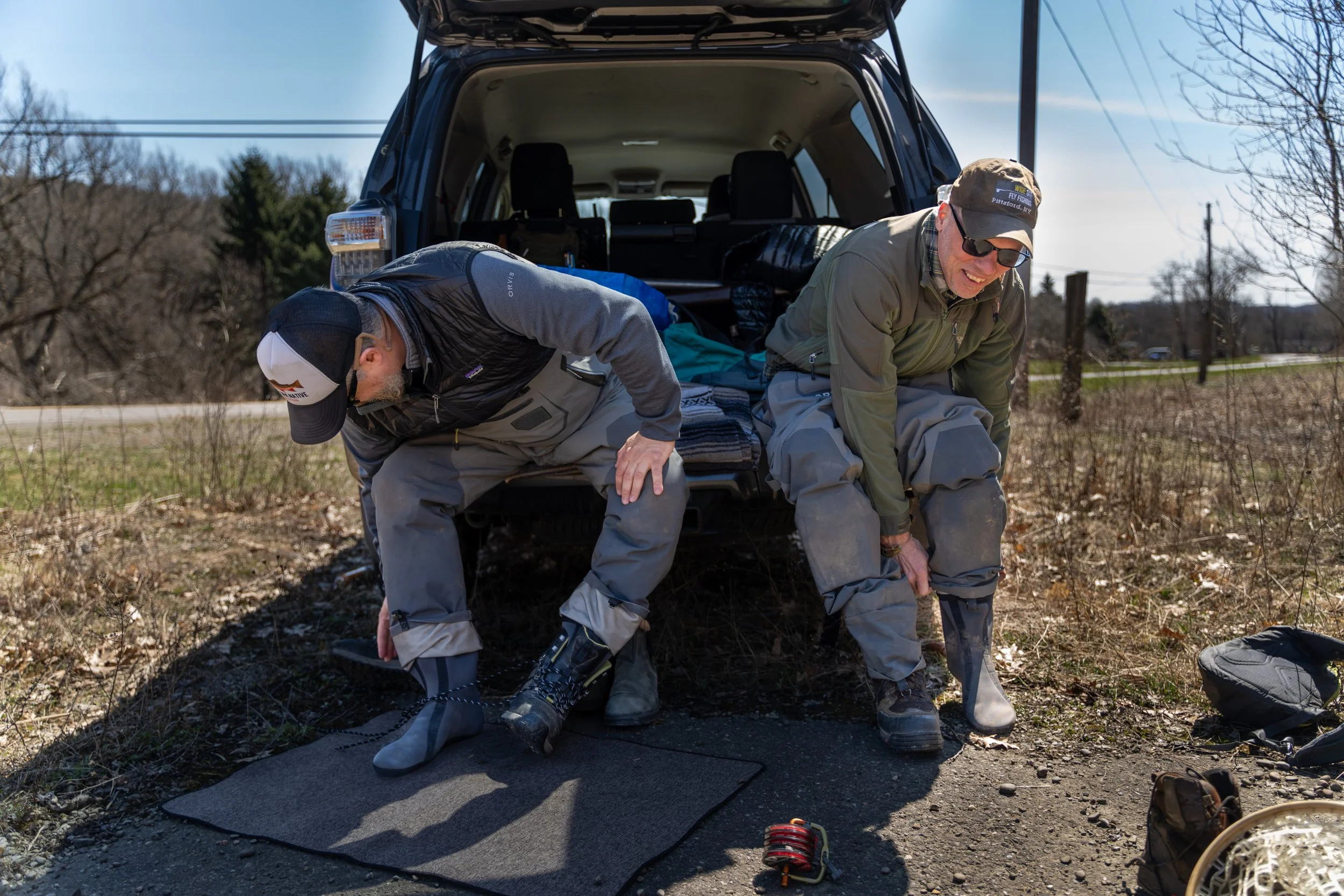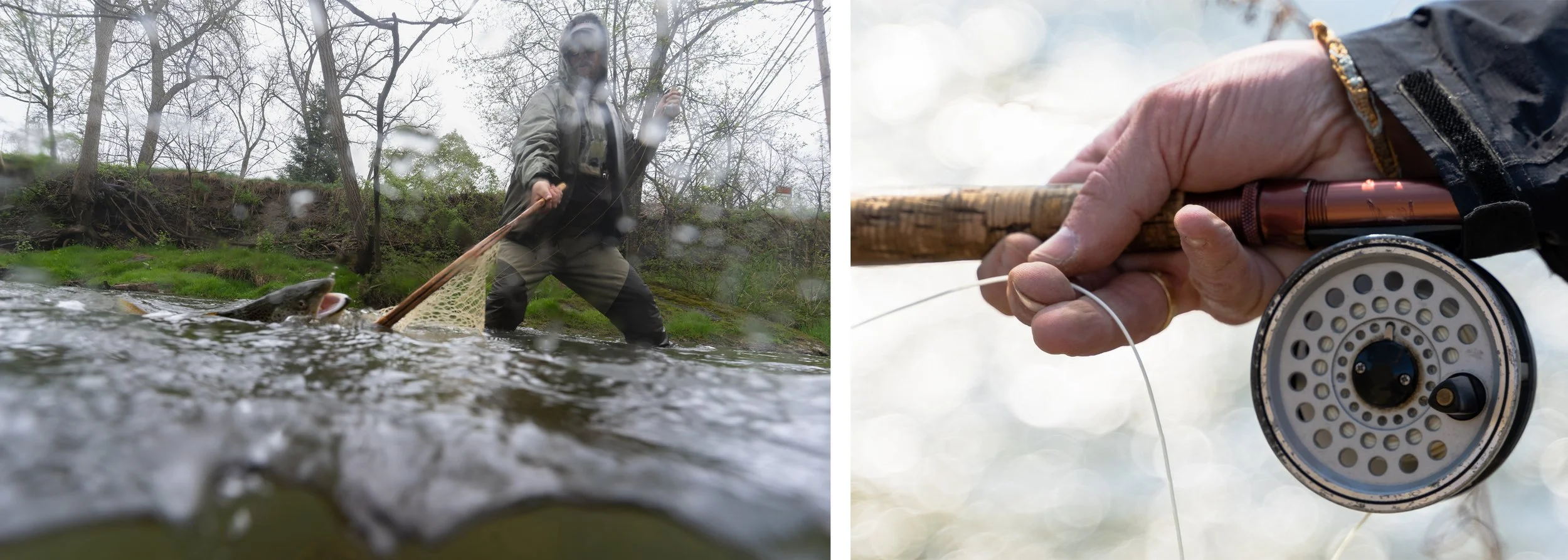Disappearing Browns
Three year old hatchery brown trout released into Oatka Creek on April 14, 2023
The world is warming and trout are suffering.
Text, images, and video by: Kayla Bartkowski
Beams of light shine through the trees while a light breeze blows across the river. It’s 67 degrees and the river is flowing quickly from the rain the day before. Aaron DeRuyter and Cal Curtice head to an inland trout stream in greater Rochester, to try their luck at fly fishing. The river is one of the very few places believed to be able to sustain wild populations in 50-70 years. The sun glimmers off the creek as Curtice and DeRuyter put on their waders and prepped their fishing rods.
Curtice and DeRuyter met in 2013 and have been fly fishing together ever since. DeRuyter was a full-time touring musician and a friend of the two introduced them to each other. Since that day, DeRuyter and Curtice have shared their love of brown trout and preserving the species.
Throughout their time fishing together, Curtice and DeRuyter have continuously documented air and water temperature to find where the brown trout are most likely to be located. Brown trout prefer temperatures between 44 to 67 degrees. They found the water level was increasing due to recent rain in the area, causing it to move faster than normal and making it harder to fish.
New York State boasts some of the greatest fishing with Lake Ontario and hundreds of streams drawing people in from all over, creating a large boost to the economy of Lake Ontario shoreline communities. The state also has one of the largest fish habitats in the nation.
However, the world is warming and along with that comes consequences. Species of fish, specifically brown trout, are declining due to their sensitivity to water temperature. Aaron DeRuyter and Cal Curtice use their love of conservation to try to find solutions to this complicated problem. Out of over 165 species, many have been negatively impacted recently due to warming in the environment.
Trout Unlimited is a National organization with chapters all over the country. “this is not a fishing organization. It is a conservation organization dedicated to conserving cold water habitats.” -Curtice
Brown trout have been a part of New York's ecosystem for over a century. Seth Green brough the first brown trout eggs to the US from Germany in the 1880s. The Genesee River's declining brown trout population has raised concerns in recent years. According to a 2019 study by the New York State Department of Environmental Conservation (DEC), there has been a decline of brown trout in the river since the 1990s and a two degree increase in the streams. According to a sampling done by the DEC at Oatka Creek Park in Scottsville, N.Y., there were 64 brown trout per 100ft in 2003. In 2016 it had dropped to 15 per 100ft and in 2019 was 21 per 100ft.
(top) DeRuyter threads fishing line through a fly on Irondequoit Creek. (bottom left) Curtice chooses one of his homemade flies to use. (bottom right) DeRuyter rests his pole on a fallen tree in the middle of the stream while he climbs over.
"This to me is the reason to live" says DeRuyter after catching a brown trout on the river. "Beautiful creature, isn't it?" DeRuyter has been spin fishing, which is the most well-known type of fishing, since he was a child, but switched to fly fishing as he grew older and fell in love with it. "It's an art. I think it's an art." says DeRuyter. "I specifically love fishing this way with some form of fly rod. If the fish are not safe and protected and being treated well, I cannot enjoy it. I don’t feel close to nature."
DeRuyter releases a brown trout he caught in the Irondequoit river. Based upon its size and coloring, he suspects it migrated from Lake Ontario.
DeRuyter has always felt a connection to the environment and believes in treating it with compassion especially when fishing. "I believe it [fly fishing] to be much safer due to just the ethics behind it and a single hook in most presentations. But also, it's science, its etymology, it’s weather, its gauging the environment and the waterflow. There's more than just tying on a purple thing with eight hooks on it and ripping it and hoping it catches something in the side of the head." DeRuyter and Curtice are members of Trout Unlimited, a national nonprofit with chapters in all 50 states. Members devote their time to protecting trout habitats and learning ways to lessen the decline in the number of brown trout, in addition to admiring the beauty of the fish.
Curtice casts into a calm spot on the Cohocton River. The fish will sit typically under and behind branches in the stiller water.
In the early morning of April 29, 2023, DeRuyter decided to take a trip to Irondequoit Creek which is around five minutes from his home. It was a rainy day along the creek with brief periods of clear skies. He started up stream and worked his way down and then back up. Throughout the creek, there are various holes that the brown trout tend to gather and the deeper parts that are covered by fallen trees make perfect home. The cool flow of the stream moved past his legs while raindrops collect on his gear as he stood waiting for a bite. DeRuyter was able to catch nine brown trout using various flies.
"My theory is that I've always caught more fish fly fishing than on gear." - DeRuyter
After each catch, DeRuyter meticulously documented the size, where he caught the fish, weather, and water temperature. He took videos of each fish to document the coloring as well as the measurements. Later at home he added the information to a diary. “I’m able to see if the population is increasing or decreasing by documenting it.” Says DeRuyter.
The coloring and size of a trout can tell their story. DeRuyter can tell if they came from Lake Ontario and migrated to the stream based upon their coloring. The trout are more silver while in the lakes and the longer they are in the streams they become more colorful. The color change to an extent is based upon the color of the substrate that is present in that particular water system. He can also tell their age by the size of the trout and if they were born in the creek or came from the hatchery. Many times, the hatchery fish are larger and have damaged fins from birds of prey while in the outdoor tanks.
(left) DeRuyter uses his phone to record the fish he captures. (right) DeRuyter's paper documentation records the size, temperature, weather conditions, and type of fish.
"In Oatka creek we had 79-degree waters this past summer,” says Curtice. “There's thermal refugees out there where there's ground water coming up and that they basically go out and sit in the cold water, but then they're exposed to predators. We're looking at potentially another project to introduce habitat structures near the thermal refugee sites so that they have a place to hide. But yeah, they're pretty much in decline because of predation and water temperature." Trout are most active and comfortably feeding when water is between 44 and 67 degrees. Once the temperature gets to 68 degrees, the fish become stressed and eat less. Tributary fish will move towards lakes when the waters get too warm, but the ones in rivers don't have access to the lakes.
In 2016, Rochester was greatly affected by three years of extreme conditions. The summers brought heat and drought that resulted in a large decrease in the trout population. "In April 2014 I stood in Oatka Creek with a dozen other anglers watching the long-awaited Hendrickson hatch [first major mayfly hatch in late April] come off in clouds,” says Curtice, “No fish rose to eat them. The Department of Environmental Conservation was inundated with calls from anglers asking what was going on at our beloved wild section of Oatka Creek Park. The DEC shared their most recent fish sampling and confirmed a precipitous decline."
Oatka Creek on April 26, 2023 in Scottsville, N.Y.
After seeing this, Curtice and members of Trout Unlimited knew they had to do something to help the trout population in Rochester. Many dead trees in the park could be used to install root wads that the trout could use for shade and protection. They got together a group of volunteers that used trees to create homes in the streams for the trout. "On the first morning, the parking lot was filled with TU volunteers, Department of Environmental Conservation, U.S. Fish and Wildlife Service, Monroe County, and contractors drinking coffee and verbally putting the plan together,” says Curtice, “Honest to God, there was a brightly lit rainbow spanning the stream as the sky cleared from a light pre-dawn rain. It was a nice moment."
Powder Mills Fish Hatchery in Pittsford, N.Y.
In 1864, known as “the father of fish culture”, Seth Green, an avid fisherman, realized that he wanted a greater supply of fish in the area after noticing a decline in the area due to pollution and over-fishing. Green decided to establish the very first fish hatchery in the United States in Rochester, N.Y. From this, the Caledonia Fish Hatchery was born. Today, the hatchery stocks 10 surrounding counties and is pushing to mitigate the effects global warming has caused on the decrease in the brown trout population.
Hatchery trout grow much fast than the wild trout. In the hatchery, there is plenty of food and the water is always the same temperature. This allows the hatchery to stock fish into local rivers around New York every day from mid-March to early June. Stocking the fish aids in establishing greater fishing opportunities for anglers. The Caledonia Fish Hatchery stocks as a “put and take” fishery as they expect most of the fish stocked to be harvested by fishermen.
(top) 2 year old Brown trout outside the Caledonia Fish Hatchery prepare to be transported and released into Oatka Creek. (bottom) Noah Czudak and Steve Galbreth gather brown trout into a net which will then be scooped up by Jason Schemer and put into the transportation trucks to be released in Oatka Creek.
"We do this whether it's 10 below and snowing or 100 degrees" says Adam Petote, a worker for the hatchery. The hatchery system produces up to a million pounds of fish annually and stocks over 1,200 water bodies for recreational and restoration purposes. Currently, there are 12 fish hatcheries throughout New York State that the DEC stocks in streams, rivers, and lakes. While some see hatcheries as a solution to the decreasing trout population, others find it to be a problem.
The process of loading fish into the truck takes many steps. First, a person goes into the pond with a wooden frame (crowder) or a net to push the fish up to the intake. The intake pulls water and fish through the pump up to the tower, which slides down into the chute to the truck tanks. Hatcheries load brown trout by displacement to know how many fish are in the truck. 80 lbs of fish raises the tank level by 1 inch. Each fish weighs around 1 lb. This results in the truck having the ability to hold around 2,000 fish.
Curtice believes that states should only stock fish in places where natural reproduction isn’t able to work naturally. Brown trout are an indicator species because they need cold, clear water. If something goes wrong, you can use it as an indication of a problem that needs to be addressed. “Part of the issue with hatchery fish and stocking is they tend to mask environmental issues and their kind of the short way out of some of those problems,” says Curtice. The stocked fish mix with the wild brown trout which makes it harder to indicate a problem is occurring with the species. The other problem with mixing stocked fish and wild fish, Curtice says, is diseases. “I think the other problem that can happen with hatchery raised fish and stocking fish is they often have disease because they're raised in, you know, pens of cement and they're fed pellets,” says Curtice, “And so they often can have the disease, and they also have genetics that don't really are suitable for survival.”
"Take care of the fish, and the fishing will take care of itself."
-Trout Unlimited
Members of Trout Unlimited aid Adam Petote in releasing the Brown Trout in Oatka Creek.
He wants stocking fish to only occur in a place where natural reproduction cannot occur therefore allowing the wild trout population to try repopulating by themselves before introducing hatchery fish. He has noticed an opportunity to shift the mindset and more strongly advocate for wild fishing being a much better way of managing out fisheries.
Robert Pickering shows his son, Aydin pickering how to at Powder Mills Park. Aydin has only been fishing a couple times, but has struck up a love for it and looks forward to continuing as he grows older.
“The important parts of the wild versus hatchery fish is talking to younger people about the importance of protecting something that’s been here for 12,000 years since the last ice age,” says Curtice. “, but I think they feel like they've been handed off this huge problem by, you know, generations that they couldn't have done anything about. And so, I feel bad about that in a way. And I want to do my part to make sure to do everything I can so that the future generations, including my daughter and my unborn grandchildren, have the opportunity to see how a natural trout stream is supposed to work.”














